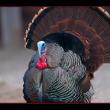Let’s talk turkey
Thanksgiving Day is almost here, and it wouldn’t be Thanksgiving without turkey, so we thought we’d share some. The wild kind, that is — the species that is, along with the Muscovy duck, the only domesticated bird that native to the New World.
The wild turkey (Meleagris gallopavo) was at one time almost extinct, so the fact that you can now see them throughout Maine (and North America) is reason to be thankful. But their status as conservation success superstars is just one of many side dishes of turkey trivia.
For example, did you know that of the 7.8 million wild turkeys breeding in North America, 89 percent occur in the U.S.? Ten percent occur in Mexico, and the remaining, roughly two percent, make their home in Canada.
These numbers represent a huge population increase compared to the turn of the 19th century, when they had been nearly hunted to extinction.
In response, people tried releasing farm birds into the wild, without success. In the 1940s, wild turkeys in one area of the continent were caught and released in areas where numbers had dwindled or disappeared. Thanks to this success, wild turkeys are now found throughout North America, and are again a favorite among hunters.
In fact, the U.S. Fish and Wildlife Service estimates that 21 percent of hunters in the U.S. hunt turkeys — this makes the species the second only to deer in popularity.
How about a few more giblets of turkey trivia? You probably know that they’re polygamous, with the handsome toms gobbling and strutting about with tails fanned out to keep their harems interested.
But how about this: wild turkeys have good eyesight, strong hearing, and are very good runners — perhaps you’ve come across them along, or even in the road and noticed that, if startled, they can scurry away surprising fast for a bird that looks as prehistoric as they do! And, they often roost over water, as an extra safety measure.
What if they should fall in? No worries; wild turkeys can swim, doing so by tucking their wings in close to the body, spreading their wide tails and kicking through the water.
You’ve probably heard the term, “talking turkey” and may have even used it yourself to describe a frank conversation.
Some believe this traces back to the colonists’ dealings with the Native Americans for this delectable species. We can’t confirm that, nor can we say for sure that the name “turkey” is a holdover from the shipping routes through Turkey (the country) as the traders brought the birds to European markets, but we thought we’d serve them up as possibilities.
We do know that this winter, as in every winter, you could see as many as 200 wild turkeys in a single flock, foraging for seeds and berries in clearings along field and forest edges.
If you’re a bird-feeding enthusiast, you may also have shared a feast of seeds with this symbol of the Thanksgiving Day feast.
Just remember, though, the next time you see one, you can also dish about the bird as a story of conservation success, worthy of a silver platter.
Event Date
Address
United States
























